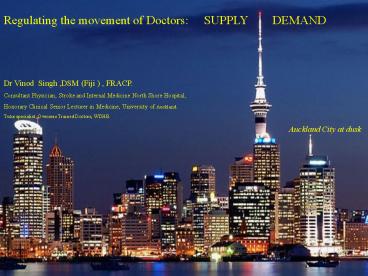Regulating the Movement of Doctors .Supply and Demand. - PowerPoint PPT Presentation
1 / 18
Title:
Regulating the Movement of Doctors .Supply and Demand.
Description:
Consultant Physician, Stroke and Internal Medicine North Shore Hospital, ... Quality: Extravirgin oil, Pomace or the grit. Economics ... – PowerPoint PPT presentation
Number of Views:90
Avg rating:3.0/5.0
Title: Regulating the Movement of Doctors .Supply and Demand.
1
Regulating the movement of Doctors SUPPLY
DEMAND Dr Vinod Singh ,DSM (Fiji ) ,
FRACP. Consultant Physician, Stroke and Internal
Medicine North Shore Hospital, Honorary Clinical
Senior Lecturer in Medicine, University of
Auckland. Tutor specialist ,Overseas Trained
Doctors, WDHB. Auckland
City at dusk
2
Why Doctors move ?
- Better Academic opportunities
- Better renumerations
- Better opportunities for family
- Safer environment
- Familiy reuinion
- Friends
- Health
- Etc etc
3
Supply and Demand orDemand and Supply
4
Supply and Demand or Demand and Supply
5
Demand the New Zealand Perspective
- Bar graph
6
IMGs to NZ workforce
- 2001 3765
- 2002 3921 156
- 2003 4156 235
- 2004 4347 191
- 2005 4471 124
- 2006 4642 171
7
IMGs to New Zealand workforce
- 2005 4471 124
- Newly registered doctors (1July2004-30th June
2005) - Trained in New Zealand 311
- International Medical Graduates 1434
- (NZREX clinical passes) 68
8
SUPPLY the new Zealand perspective
- England SA Scotland Australia India
- SriLanka USA Iraq Ireland
- Bangladesh Germany Canada
- Wales China Egypt
- Fiji (58) Yugoslavia(FedRepub of)
- Pakistan Phillipines Northern Ireland
- Zimbabawe Netherlands Russia
- Singapore Poland Myanmar
- Romania Croatia PNG Bulgaria
- Malaysia CzechRepublic.
- Japan sweden Denmark Former
- YugoslavRepublicofMarcedonia,Hungry,Switzerland
- Ukraine,Belgium,Bosnia and Herzegovina,Iran,Norway
- Others -45 countries with fewer than six doctors
- Total of 88 countries.
9
Fiji
- Developing country in the Pacific
- Population of about 800,000
- 430 Doctors in Govt Service
- 330 Locals graduates
- 100 IMGs 24
- India, Phillipines,Bangaldesh,China and Mynamar
10
Doctor migration happens in Developed countries
and Developing countries.
- So what is the problem?
- Quality of graduates
- Ease vs difficulties in filling the positions
- Economics time and money
11
Quality
- USMLE ( North American Exams
- USA Top 5-10 percentage English Language
- NZ - Pass in USMLE English Language
- Fiji NO exams Medical or Language
12
Quality Extravirgin oil, Pomace or the grit
13
Economics
- Time and money are needed in making a doctor.
14
Time - about 6 years of training to make a
doctor
15
Money
- In New Zealand
- About NZ250,000
16
Time and Money
- Local graduate
- Six years and 250K
- IMG (overseas trained doctor )
- Ready
- in the can
- and FREE
- Is there any incentive to train more ?
17
Summary
- Migration of doctors occur to developed and
developing countries but developing countries
seem to come out second best. There should be
some form of compensation eg Financial ,
technological or professional to the donor
countries. - Doctors migrate for a variety of reasons. Demand
for service is the driving factor and this demand
in Developed countries should be minimised by
training more of their own doctors . This will
cause a natural deciline in movement of doctors
from countries where they are need the most .
18
Thank You































